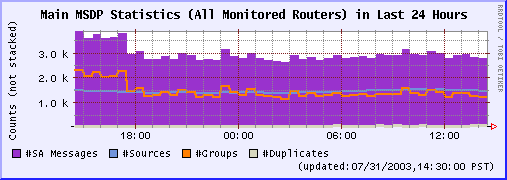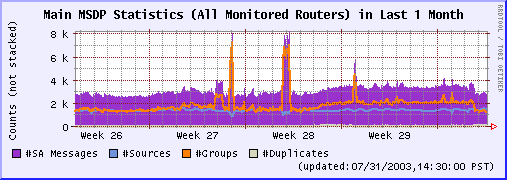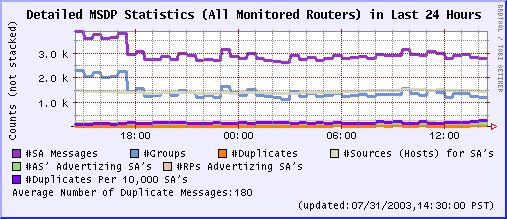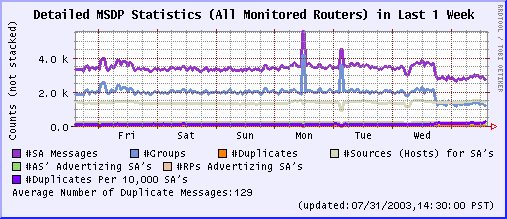Due to the ongoing increase in the deployment of sparse mode protocols; specially at the interdomain level; proper functioning of MSDP is as essential for the success of multicast as is the proper functioning of the routing protocols themselves. In this section of Mantra-WWW we analyze various characteristics of the SA (Source Active) messages to monitor the current state of MSDP. List of Available Graphs: More Info:
A brief introduction to MSDP MSDP is a mechanism to propagate information about sources--hosts sourcing any kind of data to a multicast group--and associated multicast groups to all the multicast networks. MSDP achieves this goal with the help of SA (Source Active)messages--a (S,G,RP) triplet composed of the following three fields: Source Address, Group Address and RP Address--that are propagated amongst RPs (Rendezvous Points) over TCP. As the routing protocols deployed in the multicast networks that operate in sparse mode do not support flooding information about sources, MSDP is the only mechanism through which this information can reach the network. Moreover, due to the ongoing increase in the deployment of sparse mode protocols; specially at the interdomain level; proper functioning of MSDP is as essential for successful multicast routing as is the proper functioning of the routing protocols themselves. go top Utility of the Results and How to Interpret the Graphs The information available from most of the plots is straightforward. Number of unique SAs can be, in a way, used as an activity gauge for the entire multicast infrastructure. (Note that As even the sources from networks that do not run in sparse mode or do not have native multicast, some router proxies SAs for them). More SAs imply greater number of (S,G) pairs and hence more participation/activity in the multicast networks. However, a better estimate would involve looking further into density of the groups -- group sizes -- as well as the extent of activity of the individual hosts -- how many groups is each of the host participating in simultaneously. The former puts light on the membership patterns for various groups. On the other hand, the later indicates how "attentive" hosts are to these groups, this becomes all the more important as most of the contents on Multicast still involve streaming media. Statistics about the duplicate messages is one of the direct indicators of the performance of MSDP (the other being lost SAs). Theoretically, only one RP shall announce SAs for a (S,G) pair but, as seen, in the graphs, this is not always the case. go top How does the MSDP state result into these statistics? The information represented in each of these plots is extracted from the router's SA state tables (without any snooping). As a result, all the information that is presented in these plots is derived from the data stored in a router's cache entries. To a large extent, the accuracy of these results depend on the accuracy of the information in the router-cache. If router is not caching all the SA messages that it received then these plots will depict an underestimate of the actual figures. On the other hand if the Router is keeping state for those (S,R,G) entries that are no longer active, the plots will depict exaggerated counts as they would even take in account those entries which are no longer active. go top
|


 Last 24 Hours
Last 24 Hours Last 1 Week
Last 1 Week Last 1 Month
Last 1 Month Last 24 Hours
Last 24 Hours Last 1 Week
Last 1 Week Last 1 Month
Last 1 Month